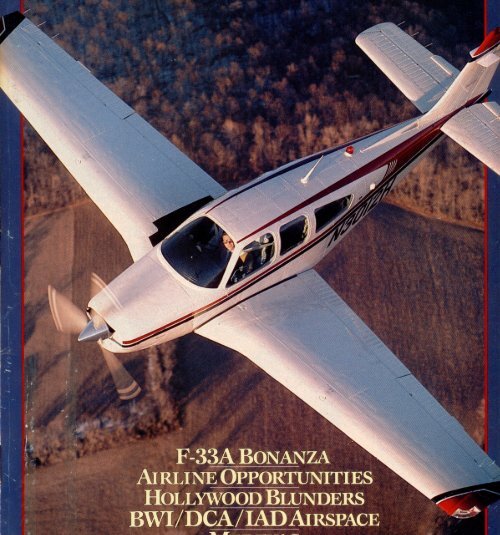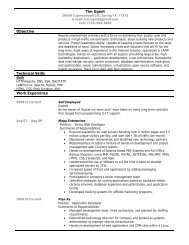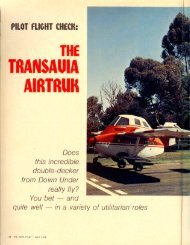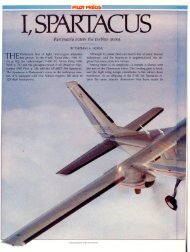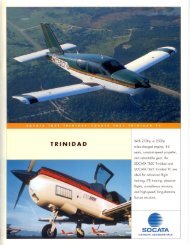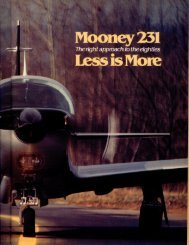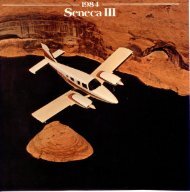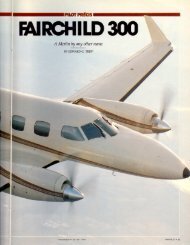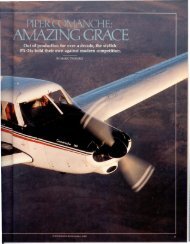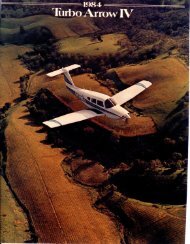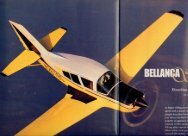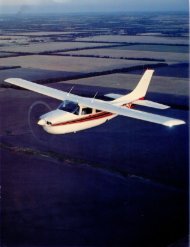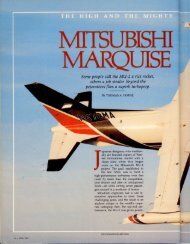F33A - Aero Resources Inc
F33A - Aero Resources Inc
F33A - Aero Resources Inc
- No tags were found...
Create successful ePaper yourself
Turn your PDF publications into a flip-book with our unique Google optimized e-Paper software.
Ever since new general aviation aircraftsales began their plummet eight yearsago, experts have debated the reasons.There is no shortage of ideas: Astronomicalproduct liability and aircraft insurancepremiums, manufacturers' narrowmindedfocus on the bottom line,shrinkage of the pilot population, increasedregulatory burdens on pilots,the strength of the used airplane market,changes in the tax laws and sticker<strong>F33A</strong>The F-33A has whatmany want in aBonanza-good ramos,dual pneumatic pumpsand a straight tail.shock are but a few of the reasons.Manufacturers have taken a closerlook at the effect of sticker shock andhave made a discovery. Demand fornew lightplanes is elastic, meaning thatsales are very sensitive to changes inprice. Lower the price, and increasedsales will follow. Not surprising, exceptfor the fact that many experts have takena glum view of an industry revitalization.Of late, general aviation manufacturingis an industry that has been pronounceddead on many occasions.While its future is by no means certain,there have been some examples ofthe market responding favorably toprice cuts. Mooney Aircraft Corporation'sM20] "Lean Machine," at $98,900(including a King-equipped IFR panel),has been particularly successful (see" ATale of Two Mooneys: Lean Machine,"October 1985 Pilot, p. 34). Mooney'sM20] Model 205, with a base price of$101,300, is also a strong seller. Othermanufacturers are also testing the waterswith base prices near the $100,000mark. There is the $92,000 Bellanca 1730A Super Viking (see "Yesterday'sWings Today: The Bellanca Viking,"November 1986 Pilot, p. 58) and60· APRIL1987
<strong>Aero</strong>spatiale/Socata Division's $72,000TB-10 Tobago (see "Pilot Precis: Tobago,"November 1981 Pilot, p. 69) and$111,000 TB-20 Trinidad (see "SocataTrinidad," September 1984 Pilot, p. 44).To this group, add Beech Aircraft Corporation'sF-33A Bonanza, discountedin January 1987 from $164,750 to$131,750. The discount was reportedlydue to Beech's obtaining price reductionsfrom component suppliers. Theprice includes an impressive list of standardequipment, including a King avionicspackage (consisting of dual navcoms,marker beacon receiver, automatic directionfinder, distance measuringequipment and a Mode A transponder),an exhaust gas temperature gauge,strobe lights, a three-blade propeller anda standby pneumatic pump.The standby pneumatic pump is electricallydriven. When the primary pumpfails, a red Gyro Warn light (located tothe lower left of the heading indicator)illuminates. The pilot must then switchthe standby gyro on and observe a riseon the instrument air pressure gauge.Both pumps are of the pressure type,manufactured by Airborne. The pilot'soperating handbook advises that thepneumatic system filters be replaced atleast every 300 hours of operation. Thestandby pump should be replaced every600 hours of system operation.A standby generator is also available,but not from the factory. The cost of thispart is approximately $1,600, not includinginstallation. Beech requires thatstandby generators be inspected every100 hours and overhauled or replacedevery 1,500 hours.The avionics options list consists of aKing KEA-130 transponder with encodingaltimeter ($2,295) and a King KFC150 autopilot/flight director with aslaved KI-525A-00 horizontal situationindicator ($25,525). This latter option includeselectric pitch trim. As' for theKEA-130, it is difficult to understandwhy this was made an option. For anairplane of this capability and price, analtitude-reporting transponder shouldbe part of the standard package.Other options include:• A fifth seat ($1,590)• Air conditioning ($10,950)• Electric propeller anti-ice ($3,250)• A 100-ampere/hour alternator($795). Air conditioning and propelleranti-ice require the power output of thisalternator.• Copilot brakes ($995)• Dual control wheel ($795). The stan-'dard single control wheel is of thethrow-over type.The F-33 Bonanza has been a popularairplane ever since its introduction in1970. Then, it was powered by a 225horsepower Continental 10-470-K engineand marketed as a replacement inname for the Model 33 Debonair series,In 1971 the F-33A was introduced. Thisaircraft, like all succeeding F-33As, waspowered by the 285-hp 10-520-B.Today, there are some 1,700 Debonairsand F-33s on the Federal AviationAdministration's civil aircraft registry.And according to the Aircraft BlueBook-Price Digest, they have held theirvalue well-a testimony to their durabilityand appeal. Average retail pricefor a 1970 F-33 is approximately$42,500, only $3,000 or so below whatits average new price was. Alarge factorin the F-33's staying power in the usedmarket may be the concern over the integrityof the Model 35's V-tail, concernthat has generated an airworthiness directivelimiting these airplanes' maximumcruise speeds (see "Pilot News:Beech Restricts V-Tail Bonanza Speeds,"December 1986 Pilot, p. 23).The 1987 F-33A has the same solidfeel, roominess and comfort as its predecessors.Pilots and passengers sit tall andhave good visibility and high-qualityseats. Center armrests are standard.Equally pleasant are the airplane's handlingqualities and the flexibility affordedby its Va of 134 KIAS and its.Vloand Vfe of 154 KIAS. Control responsivenessand harmony are very good.The general impression is one of highquality and pride in workmanship.There are some cautions, however.One is the nonstandard arrangement oflanding gear, flap and mixture controls.The F-33A was certificated in 1970 undergrandfathering provisions of CivilAviation Regulation 3, the forerunner oftoday's Federal Aviation Regulation Part23. That was in the days before the standardizationof cockpit instrumentationand controls. Like all pre-1983 Bonanzas(the year when the A36 and B36TC Bonanzaschanged their panel configurationsto meet modem standards), the F33 has its flap switch on the left side ofthe center console, above the throttle.The landing gear switch and landinggear position indicator lights are to theright of the propeller rpm control. Pilotsfamiliar with the modem standardgearswitch on the left, flap switch onthe right-can be tricked into inadvertentlyretracting the landing gear. WithAOPA PILOT. 61
dual controls, the chance of activatingthe wrong switch is more likely. Thelarge bar that connects the control yokesobscures the pilot's view of the subpanelwhere they are located.The landing gear switch is guarded bya plastic cover to help prevent inadvertentretraction, but the most effectiveways to avoid the problem are to becomethoroughly familiar with the airplaneduring the checkout process andto double-check your actions before activatingthe switches.The same can be said for the mixturecontrol, which is below the throttle. Untila pilot gains the necessary familiarity,there is apt to be some fumbling whileadjusting propeller and mixture controls.The fuel selector is awkwardlyplaced, too-beneath the pilot's leftknee, all but tucked out of sight.Weight and balance should be anotherconcern. Yes, the airplane can befitted with a fifth seat. And yes, the rearcargo area can accommodate 270pounds. But careful preflight weight andbalance and center of gravity computationswill reveal that aft loadings mustbe made very carefully. The fifth seatpromises more than it delivers. For allpractical purposes, the F-33A Bonanza isa four-place airplane.Most people will find the airplane'sshortcomings of little consequence, consideringits many attributes. Slowly, customersare responding to the price incentive.In 1986 Beech sold 28 F-33As.Oil capacityIt is difficultto understandwhy the airplanewas not fitted witha Mode C transponder.Beechcraft Bonanza F-33ABase price: $131,750SpecificationsPowerplant Teledyne ContinentaII0-520-BB285 hp @ 2.700 rpm/full throttleRecommended TBO 1,500 hrPropeller McCaIJley constant-speedthree-blade, 80 in diaRecommended TBO 1,500 hr or 5 yr20 ft 8 in8 ft 3 in33 ft 6 inLengthHeightWingspanWing areaWing loadingPower loadingSeatsCa bin lengthCabin widthCabin heightBasic empty weightEmpty weight, as testedMax ramp weightUseful loadUseful load, as testedPayload w /full fuelPayload w /full fuel, as testedMax takeoff weightMax landing weightruel capacity, std80 gal (74 gal usable)12 qtTwelve were sold in January and Februaryof this year, and the company expectsto sell 100 by year's end.It is an encouraging sign, Perhaps thegeneral aviation industry is not dead afterall. It may have just been sufferingfrom a lack of creative marketing conceptsor-more to the point-an inabilityto listen to its customers, DBaggage capacity 270 lb, 36.7 cu ftPerformanceTakeoff distance, ground roll 1,000 ftTakeoff distance over 50-ft obst 1,769 ftMax demonstrated crosswind component 17 ktRate of climb, sea level 1,167 fpmCruise speed/endurance w/45-min rsv(fuel consumption)@ 75% power, 8,000 ft 170 kt/4.4 hr(86.4 pph/14.4 gph)@ 65% power, 8,000 ft 163 kt/4.8 hr(79.8 pph/13.3 gph)181 sq ft Service ceiling 17,858 ft18.8 Ib/sq ft Landing distance over 50-ft obst 1.324 ft11.9 Ib/hp Landing distance, ground roll 800 ft4 or 5limiting and Recommended Airspeeds10 ft 1 inVx (Best angle of climb) 77 KIAS3 ft 6 inVy (Best rate of climb)96 KIAS4 ft 2 in2,1251bVa (DesignVfe (Maxmaneuvering)flap extended, approach)134 KIAS154 KIAS2,268 Ib Vfe (Max flap extended, full) 123 KIAS3,4121b1,2871bVIe (Max gearVlo (Max gearextended)operating)154 KIAS154 KIAS1,1441b Vno (Max structural cruising) 167 KIAS8431b700lbVne (NeverVs 1 (Stall,exceed)clean)196 KIAS64 KIAS3,400 Ib Vso (Stall in landing configuration) 52 KIAS3,400 Ib All spedficatiolls are based 011 mallllfacillrer's480 Ib (444 Ib usable) (a/cllialiolls. All performallCt' figllres are based 011stalldard day, stalldard atmosphere, al sea lel.e!alld gross weight, IIl1less othem'ist' 1I01ed.64. APRIL 1987


